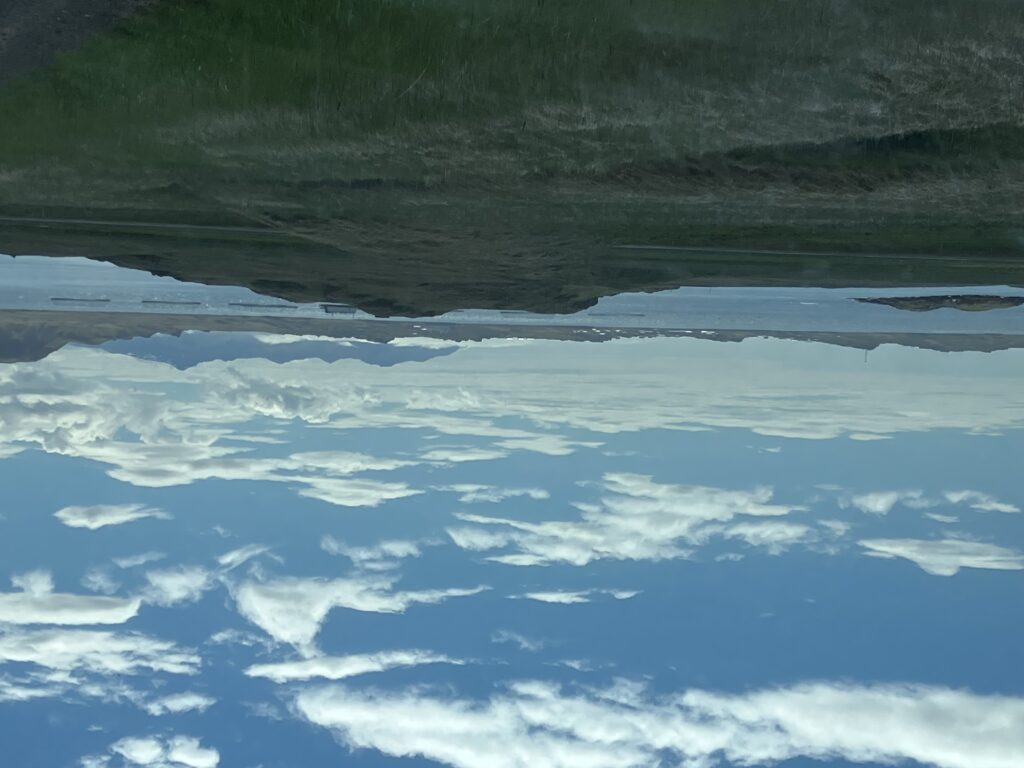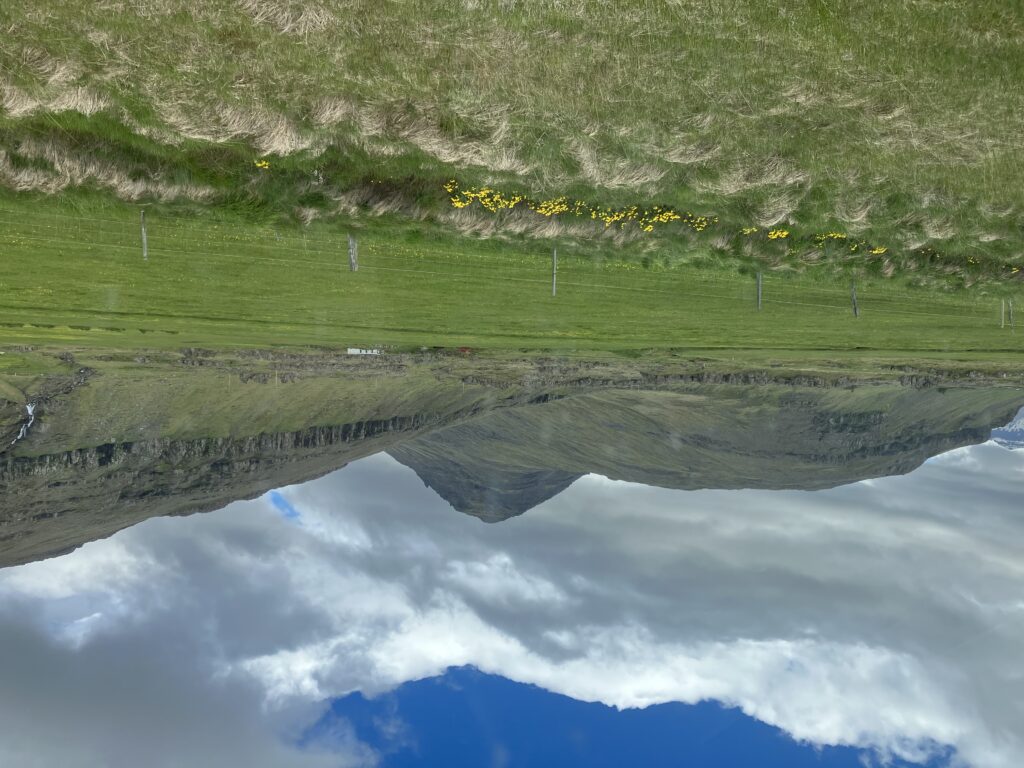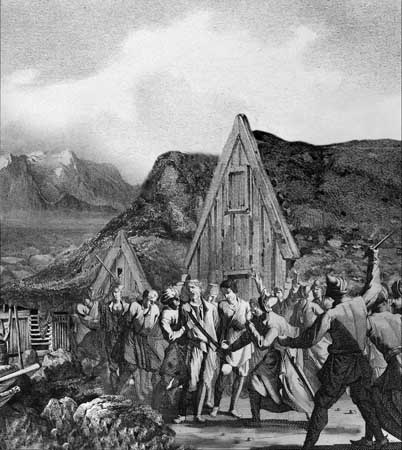This week, we continue with a series of excerpts from Enslaved: The Story of the Barbary Corsair Raid on East Iceland in 1627, the book my Icelandic colleague, Karl Smári Hreinsson, and I recently published.
Here is this week’s excerpt.
(Because this is a translation of a four-hundred-year-old document, remember, background explanation is sometimes required; we have done this with footnotes. We have also added clarifications in the text in square brackets where needed.)
After the pirates had ferried the Danes [taken captive in Djúpivogur] to the Turkish warships, they [formed a raiding party] and then got into two boats and rowed north along the fjord to Berunes farmstead.
Bjarni Jónsson, a silversmith who was master of Berunes [farmstead], managed to escape with all his people, along with several others from farms in the surrounding area, and flee inland up one of the valleys [that led through the mountains]. Others, however, mistakenly believed that the pirates would be ordinary peaceful men and did not flee.[1]
(The first photo below shows the view of Berufjörður from Berunes farm. The tiny white specks in the distance on the far side of the fjord are the houses of Djúpivogur. As you can see, the folk at Berunes farm had a splendid view of the fjord and would have spotted the corsair ships quite easily, and so been forewarned that something bad was afoot. The second photo is of the farm at Berunes today and shows the route probably taken by the farm folk to escape up into the hills.)


Two of Bjarni’s folk, riding good horses, came back to see what was happening in the area. There was a thick fog covering half the hillside.[2] They took the same route back that they had taken to escape up into the mountains, but because of the fog, they had to ride far down into the valley [to see anything]. When they were nearly out of the valley, they spied eight men coming towards them. They believed these men were Icelanders because they were driving sheep ahead of them. Bjarni’s men, who were not worried, thought they might be able to get some news [about the corsairs].
When they drew near, though, they saw that the men were armed. Both groups stood and stared at each other. Bjarni’s two men thought that all eight of the men confronting them were pirates, and so they turned and retreated. However, it was in fact only one Turk who was herding seven bound Icelanders in front of him—including Magnús Þórðarson, from Berufjörður farm, and his sons.[3]
The pirate chased after Bjarni’s two men. Initially he got close to them, but he failed to catch them because he ran out of breath before the horses did. He was also encumbered by the weapons he carried. Bjarni’s two scouts returned to their people, and they all fled north into Breiðdalur.
The pirates who had marched along the coastline [on the northeast shore of the fjord] captured three men from the farm at Þiljuvellir. From Gautavík, they took nine men, from Skáli ten men. From Kelduskógar, they took a married couple, a maid, and a young man. From Berufjörður farm, they took five children and four men, the farmer, his two grown sons, and the farmhand. These four men they found up on the mountain called Steinketill.[4]
(The photo below shows Steinketill (Stone Kettle) Mountain.)

At Berunes, the pirates took two old women. However, all the people had fled from Karlsstaðir, the farm just beyond Berunes [to the east], except for a vagrant boy who was lying sick there. The pirates slit his throat and cut his arm off. From a tenant farm nearby, they took a man who lived there along with two children, and a third in the cradle. From Steinaborg, they took a young man; from Fossgerði, they took a couple with a child; from Krossgerði, a married couple; from Kross, they took the farmer and two farmhands; from Sjávarborg, a man; from Núpur, three men and two young men from [the island of] Papey.
They transported all these people to their ships on that same day [July 6]. Then they sent a boat up to Berufjörður farm to fetch Reverend Jón Þorvarðsson, his wife, and the other captives who had been left there. By the time the evildoers had finished collecting these poor, captive folk, it was close to noon. They then went ashore again to raid farms on both sides of the fjord, which they did until evening. This all happened on Friday [July 6].[5]
For a further excerpt from Enslaved, see the next post here in this blog.
__________
[1] The locals who mistook the corsair raiders for “ordinary peaceful men” might genuinely have misunderstood the situation. Alternatively, they might have assumed these raiders to have been English, and therefore represented more nuisance value than genuine threat. When the corsairs from Salé attacked the Grindavík area, in southwest Iceland, the locals there did not attempt to flee because they thought the raiders were English and therefore only interested in stealing portable goods—not people. By the time they realized their mistake, it was too late. Perhaps the people around Berunes farmstead had a similar experience.
[2] Fog is very common in the East Fjords.
[3] Magnús Þórðarson was the master of Berufjörður farmstead. Earlier in the skólapiltar report, we are told that he was some distance away from his farm when the corsairs attacked. It appears that he had the misfortune to encounter one of the marauding corsair bands, and that he was captured along with several of his sons.
[4] The farmer from Berufjörður farmstead who was captured, along with his two grown sons and a farmhand, on the slopes of Steinketill mountain, seems to be the same Magnús Þórðarson who was among the captives guarded by the lone corsair who encountered the two scouts sent out by Bjarni Jónsson, the silversmith (who was master of Berunes farmstead). Steinketill mountain is located only a couple of kilometres (a little over a mile) northeast of Berunes farmstead. So perhaps Magnús and his entourage were visiting Berunes farm. Perhaps they were among the folk who mistook the corsair raiders for “ordinary peaceful men” and so were easily taken.
[5] The skólapiltar report is not entirely clear, but on the first day of the raid, there seems to have been two bands of corsair raiders. The first band assailed the Danish trading post at Djúpivogur and then went on to pillage the farms at Búlandsnes, Háls, and Berufjörður, on the southwest coast of the fjord. From Berufjörður farm, they hiked back along the fjord’s northeast shore to Berunes, where the corsair ships were anchored. The second band of corsairs rowed ashore at Berunes from the corsair ships and then appear to have split up and set off in two directions. One group went northwards along the northwest shore of the fjord, attacking the farms at Þiljuvellir, Gautavík, Skáli, and Kelduskógar. Whether they connected with the corsairs returning from Berufjörður farm, the skólapiltar report does not say. The second group of corsairs struck out along the coastline of Berufjarðarströnd, which consisted of a narrow, flat coastal plain—varying from about a third of a mile to one mile (1/2 – 1 kilometer) wide—butting up against the mountainous interior. The land on this coastal plain was arable, and farms were strung out all along it. The corsairs who plundered this area hit one farm after another as they moved eastwards: Karlsstaðir, Steinaborg, Fossgerði, Krossgerði, Kross, Sjávarborg, and Núpur, an overland distance of perhaps fifteen kilometres (just under 10 miles). Because of the confusion in parts of the skólapiltar report (see note 17 above), it is challenging to calculate the exact number of captives taken by these corsair bands, but as best we can determine, the total adds up to 109 (18 Danes and 91 Icelanders). This part of the raid was over by midday. The corsairs later “went ashore again to raid farms on both sides of the fjord, which they did until evening.” The skólapiltar report makes no mention of how many more captives the corsairs took by the time the day ended, however, so there is no telling what the total count for July 6 might actually have been.
 The Travels of Reverend Ólafur Egilsson
The Travels of Reverend Ólafur Egilsson
The story of the Barbary corsair raid on Iceland in 1627
Amazon listing